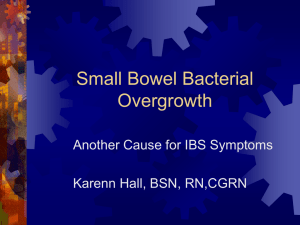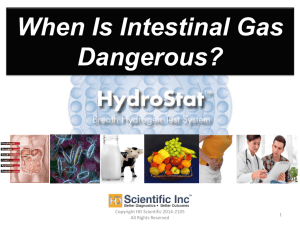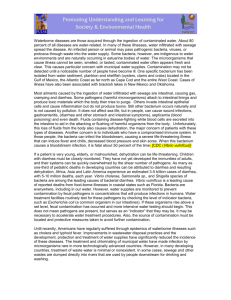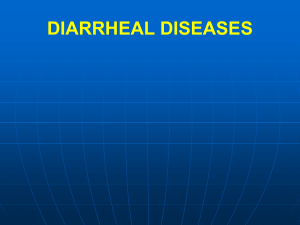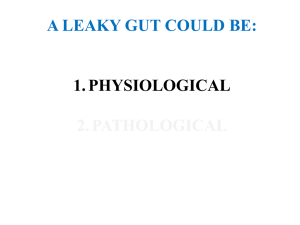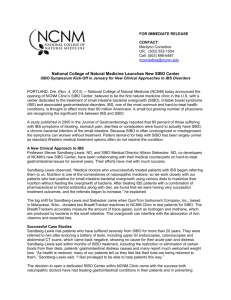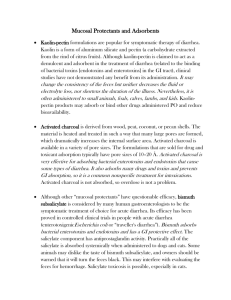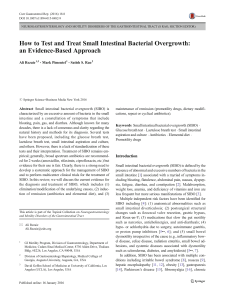IBD: Moving Away from Immune Suppressants and Towards a Cure
advertisement
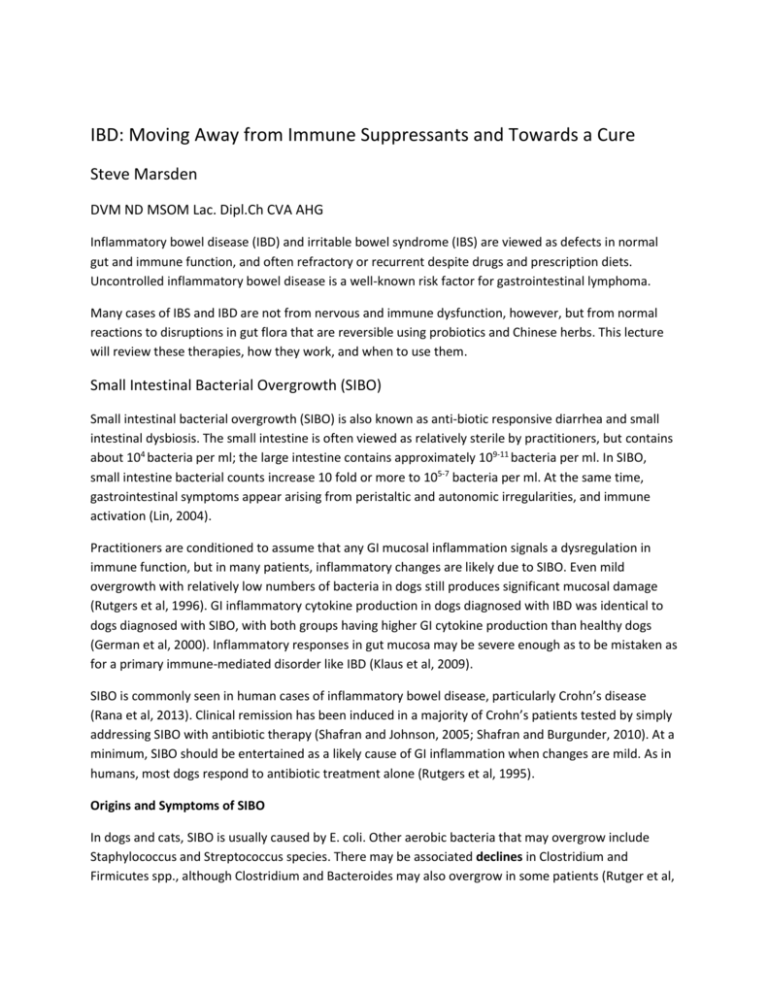
IBD: Moving Away from Immune Suppressants and Towards a Cure Steve Marsden DVM ND MSOM Lac. Dipl.Ch CVA AHG Inflammatory bowel disease (IBD) and irritable bowel syndrome (IBS) are viewed as defects in normal gut and immune function, and often refractory or recurrent despite drugs and prescription diets. Uncontrolled inflammatory bowel disease is a well-known risk factor for gastrointestinal lymphoma. Many cases of IBS and IBD are not from nervous and immune dysfunction, however, but from normal reactions to disruptions in gut flora that are reversible using probiotics and Chinese herbs. This lecture will review these therapies, how they work, and when to use them. Small Intestinal Bacterial Overgrowth (SIBO) Small intestinal bacterial overgrowth (SIBO) is also known as anti-biotic responsive diarrhea and small intestinal dysbiosis. The small intestine is often viewed as relatively sterile by practitioners, but contains about 104 bacteria per ml; the large intestine contains approximately 109-11 bacteria per ml. In SIBO, small intestine bacterial counts increase 10 fold or more to 105-7 bacteria per ml. At the same time, gastrointestinal symptoms appear arising from peristaltic and autonomic irregularities, and immune activation (Lin, 2004). Practitioners are conditioned to assume that any GI mucosal inflammation signals a dysregulation in immune function, but in many patients, inflammatory changes are likely due to SIBO. Even mild overgrowth with relatively low numbers of bacteria in dogs still produces significant mucosal damage (Rutgers et al, 1996). GI inflammatory cytokine production in dogs diagnosed with IBD was identical to dogs diagnosed with SIBO, with both groups having higher GI cytokine production than healthy dogs (German et al, 2000). Inflammatory responses in gut mucosa may be severe enough as to be mistaken as for a primary immune-mediated disorder like IBD (Klaus et al, 2009). SIBO is commonly seen in human cases of inflammatory bowel disease, particularly Crohn’s disease (Rana et al, 2013). Clinical remission has been induced in a majority of Crohn’s patients tested by simply addressing SIBO with antibiotic therapy (Shafran and Johnson, 2005; Shafran and Burgunder, 2010). At a minimum, SIBO should be entertained as a likely cause of GI inflammation when changes are mild. As in humans, most dogs respond to antibiotic treatment alone (Rutgers et al, 1995). Origins and Symptoms of SIBO In dogs and cats, SIBO is usually caused by E. coli. Other aerobic bacteria that may overgrow include Staphylococcus and Streptococcus species. There may be associated declines in Clostridium and Firmicutes spp., although Clostridium and Bacteroides may also overgrow in some patients (Rutger et al, 1995). One possible consequence of altered flora composition is reduced short-chain fatty acid (SCFA) synthesis by bacteria from ingesta. SCFAs are an important source of energy for the GI epithelium. SIBO may be a primary cause of gastrointestinal disease, or occur secondarily. Disrupted motility or anatomical changes associated with GI pathology may trap bacteria in the small bowel. Motility impairments and SIBO are observed in most cases of Crohn’s in humans (Rana et al, 2013). Inflammation then arises secondarily which compounds the original pathology. Thus, to paint the relationship between GI inflammation and SIBO as linear may be misleading. The relationship is likely selfpropagating and circular, with treatment of dysbiosis being an important stepping stone in the management of almost all GI disease. Nevertheless, there are clear risk factors for dysbiosis. These include: Immune suppression from use of immune suppressant drugs in IBD Removal of anatomical barriers between the colon and small intestine o E.g. Ileo-cecal valve damage Use of proton pump inhibitors such as omeprazole (Prilosec) Exocrine pancreatic insufficiency in small animals In the latter two conditions, lack of hydrochloric acid and proteolytic enzyme activity allows flora consumed with food to survive and proliferate. As non-commensal organisms proliferate, an inflammatory response is generated that damages the gut wall and impairs digestion. The former leads to a secretory diarrhea and the latter leads to an osmotic diarrhea. In clinical cases of SIBO, the key symptoms include vomiting, diarrhea, and weight loss. SIBO is easily diagnosed from examination of jejunal fluid, but this is impractical as a routine procedure in small animal medicine. One study in dogs showed a tenfold increase in serum conjugated bile acids in response to dysbiosis (Melgarejo et la, 2000). Otherwise, it should be suspected as a major contributing factor in any patients with diarrhea lasting longer than three weeks. Although results of antibiotic treatment are not always consistent, the diagnosis is also implied by a response to antimicrobial treatment. Hence the alternate name of the condition – antibiotic-responsive diarrhea. Treatment of SIBO First line treatment of SIBO and, by extension, IBD includes the following: Elimination of aggravating factors. o Minimum required doses of immune suppressant medications should be sought, or the drugs discontinued if contribution to well-being is minimal o Proton pump inhibitors should be discontinued if possible Normalize gut motility Support normal flora, for example through use of prebiotics While response to antibiotics has underscored the role SIBO plays in IBD, antimicrobial therapy should be considered a second line treatment. Antimicrobials carry the risk of further disrupting GI flora, and no one drug proves consistently helpful. Generally the drugs most advocated include the fluoroquinolones, trimethoprim-sulfa, and metronidazole. Most research on SIBO is conducted using rifaximin, an antibiotic for traveller’s diarrhea that has the advantage of staying in the gut. Rifaximin is used primarily as a preventive for Traveller’s Diarrhea. If antibiotics are to be used, it is advised they be used one week at a time, repeated monthly, as needed. Probiotics should probably be administered simultaneously, to help colonize the spaces left behind as pathogens are cleared. Probiotics do not need to contain native species of the canine and feline gut. Lactobacillus and Enterococcus can colonize the small animal gut despite not being important native species. Like the E. coli they are replacing, they are able to adhere to the gut lining, and will manufacture SCFAs to support the gut lining as they do in humans. These species will also break down toxic compounds as they do in humans, and will spur IgA synthesis and stimulate native immunity. Even dead bacteria of inferior products are beneficial in this regard. Prebiotics can help assure the successful colonization of the gut by Bifidobacterium and Lactobacillus. An example includes lactosucrose, an important food source for these species. Herbal Therapies Herbal therapies can be used in conjunction with pharmaceuticals, helping to normalize motility. In addition, depending on the formula, they can boost immunity against pathogenic bacteria while helping to remove them. Lastly, they can help remove the role of stress in aggravating IBD and promoting irritable bowel syndrome (IBS). Two herbal formulas prove consistently helpful in SIBO: o o Bu Zhong Yi Qi Tang (Ginseng and Astragalus Combination, Natural Path Herb Company; Boost the Qi, Kan Herb) Huo Xiang Zheng Qi San (Agastache Combination, Natural Path Herb Company; Protect the Middle, Kan Herb) Bu Zhong Yi Qi Tang(Ginseng and Astragalus) The English name of the formula captures the main effects of the formula perfectly. Rather than being anti-inflammatory, the formula supports normal persistalsis with its content of Astragalus, Bupleurum, Citrus peel and Licourice. Both constipation (another symptom of dysbiosis) and small bowel diarrhea respond. Ginseng reduces excessive stress responses, minimizing the adverse impact of the psyche on gut motility and immunity. Astragalus is a notable immune stimulant, rallying the response against pathogenic bacteria by increasing antigen-presentation. Bupleurum boosts humoral immunity but interferes with autoimmune processes triggered by T cells. White Atractylodes has a long history of use in diarrhea. Consider the formula particularly for diarrhea that worsens in the early morning hours, and during winter. Associated conditions that may be either concomitant or salient features of the patient’s history include fatigue, anemia, anxiety, fecal and urinary incontinence, rectal prolapse, dysuria, and feline lower urinary tract obstruction. Table 1 - Bu Zhong Yi Qi Tang (Ginseng and Astragalus Combination) Ren Shen Ginseng root Dang Gui Shen Chinese Angelica root Huang Qi Astragalus root Bai Zhu White Atractylodes rhizome Chai Hu Bupleurum root Chen Pi Citrus peel Gan Cao Licorice root Sheng Ma Cimicifuga rhizome Table 2 - Huo Xiang Zheng Qi San (Agastache Combination) Huo Xiang Bai Zhi Zi Su Ye Hou Po Jie Geng Da Fu Pi Chen Pi Bai Zhu Fu Ling Ban Xia Gan Cao Agastache Angelica dahurica Perilla leaf Magnolia Platycodon Areca peel Citrus peel White Atractylodes Poria Pinellia Licourice root Huo Xiang Zheng Qi San (Agastache Combination) Agastache is a strong antimicrobial formula. It has a broad spectrum of effect against many species of viruses, nematodes, fungi, and bacteria. There are 26 different antimicrobial compounds in Agastache alone (Yang et al, 2013). Agastache also Interferes with cell adhesion (Zielinska and Matkowski, 2014), thereby reducing white blood cell ingress into the interstitium and subsequent inflammation. Agastache Combination seems particularly reliable in resolving diarrhea in young dogs and cats, whether from bacterial or viral causes, and even in cases those which have proven refractory to antimicrobial pharmaceuticals. Agastache Combination is also consistently effective in resolving diarrhea from Clostridium species. The following table provides the author’s starting dose recommendations for liquid, tablet and granular extracts for both formulas BID Dose BID Dose Weight (kg) Weight (lbs) BID Dose (mls)* (550 mg tabs)** (tsp granular extracts)*** 4 10 0.30 1.00 0.25 8 20 0.45 1.50 0.50 12 25 0.60 2.00 0.75 23 50 0.90 3.00 1.00 32 70 1.20 4.00 1.50 /5 150 1.80 6.00 2.00 120 250 2.40 8.00 3.00 * At the present time, only Kan Veterinary Essentials provides the formulas in liquid form ** Tablets available from Kan Veterinary Essentials *** Required dose of granules from Natural Path Herb Company may be as little as half these amounts, due to their higher purity and lack of excipients Case Example Mushi, a 16 yo spayed female Japanese Bobtail, presented with a chief complaint of persistent explosive diarrhea from Clostridium perfringens enterotoxin. Prior to this, Mushi had been managed for presumed inflammatory bowel disease from age five to seven with prednisone. The condition presented as colitis and was aided by metronidazole and fenbendazole. The condition did not resolve, however, until age 7 when a commercial raw diet was introduced and San Ren Tang (Three Seeds Combination, Kan Herb) prescribed. Following resolution of the diarrhea, prednisone was discontinued. The stools became small and hard and were managed with lactulose and continued San Ren Tang. From ages 7 to 14, Mushi experienced two or three episodes of anal gland abscess, which rapidly resolved with conventional management. In October of 2013, at age 15, Mushi experienced another abrupt onset of explosive diarrhea. San Ren Tang had long been discontinued. This time there was no blood or mucous, but Mushi was inappetant. Over the past year, Mushi had experienced rectal prolapse tendencies and these were aggravated by the diarrhea. Mushi became lethargic, had a pale tongue, and a weak pulse. Acupuncture that aided Mushi’s demeanour and pulse included sedation of BL 40 and 13, and tonification of SP 6 and BL 20. A Chinese medical diagnosis of Wind invasion and associated Spleen Qi deficiency was rendered. In Chinese medicine, the term ‘Wind’ is often applied to patients experiencing infection of epithelial surfaces. ‘Spleen Qi deficiency’ translates to general digestive tract weakness. Based on a presumed role of infection, Mushi was prescribed Huo Xiang Zheng Qi San (Agastache Combination, Natural Path Herb Combination), a probiotic (Fortiflora, Purina) and Cefovecin (Convenia). Mushi experienced an improvement in her appetite, but regular episodes of explosive diarrhea continued. At this point, tylosin, metronidazole, amoxicillin and feeding of i/d were all tried, to no avail. Diarrhea episodes continued every 3rd or 4th day. In January, Mushi began also to exhibit frequent urination with her diarrhea episodes. Mushi now had fecal incontinence and her prolapse became severely inflamed and hemorrhaged. Mushi’s appetite declined once more. Ultrasound examination showed a small intestine dilated with fluid. Jejunal lymphadenopathy was noted. Aspirates were positive for C. perfringens enterotoxin on PCR testing. Mushi was otherwise negative for enteric pathogens on fecal testing. Immediately following the ultrasound, Bu Zhong Yi Qi Tang (Ginseng and Astragalus Combination) was prescribed based on a worsening in late fall and winter; a worsening of the prolapse; concomitant dysuria; fatigue; loss of appetite; and previous constipation. The intents of the formula were to bolster immunity, improve appetite, and regulate peristalsis. Mushi was administered 1/8 tsp BID of Bu Zhong Yi Qi Tang (Natural Path Herb Company) and also given B12 at a dose of 0.50 ml subcutaneously once weekly. Fortiflora was continued. No further antibiotics were administered due to a lack of response to previous treatment. Over the next month, Mushi’s stool slowly returned to normal, with just one episode of soft stool every 8-9 days. Bowel movements were no longer explosive or uncontrollable. Mushi’s appetite returned to normal. The lifelong prolapse persisted but was no longer bleeding or inflamed. References Cited Batt RM. Exocrine pancreatic insufficiency. Vet Clin North Am Small Anim Pract. 1993 May;23(3):595608. German AJ, Helps CR, Hall EJ, Day MJ. Cytokine mRNA expression in mucosal biopsies from German shepherd dogs with small intestinal enteropathies. Dig Dis Sci. 2000 Jan;45(1):7-17. Lin HC. Small intestinal bacterial overgrowth: a framework for understanding irritable bowel syndrome. JAMA. 2004 Aug 18;292(7):852-8. Melgarejo T, Williams DA, O'Connell NC, Setchell KD. Serum unconjugated bile acids as a test for intestinal bacterial overgrowth in dogs. Dig Dis Sci. 2000 Feb;45(2):407-14. Rana SV, Sharma S, Malik A, Kaur J, Prasad KK, Sinha SK, Singh K. Small intestinal bacterial overgrowth and orocecal transit time in patients of inflammatory bowel disease. Dig Dis Sci. 2013 Sep;58(9):2594-8 Rutgers HC, Batt RM, Elwood CM, Lamport A. Small intestinal bacterial overgrowth in dogs with chronic intestinal disease. J Am Vet Med Assoc. 1995 Jan 15;206(2):187-93. Rutgers HC, Batt RM, Proud FJ, Sørensen SH, Elwood CM, Petrie G, Matthewman LA, Forster-van Hijfte MA, Boswood A, Entwistle M, Fensome RH. Intestinal permeability and function in dogs with small intestinal bacterial overgrowth. J Small Anim Pract. 1996 Sep;37(9):428-34. Shafran I, Johnson LK. An open-label evaluation of rifaximin in the treatment of active Crohn's disease. Curr Med Res Opin. 2005 Aug;21(8):1165-9. Shafran I, Burgunder P. Adjunctive antibiotic therapy with rifaximin may help reduce Crohn's disease activity. Dig Dis Sci. 2010 Apr;55(4):1079-84 Tirpitz C C. Small intestinal bacterial overgrowth mimicking acute flare as a pitfall in patients with Crohn's Disease. BMC Gastroenterol. 2009 Jul 30;9:61 Yang X, Zhang X, Yang SP, Liu WQ. Evaluation of the antibacterial activity of patchouli oil. Iran J Pharm Res. 2013 Summer;12(3):307-16. Zielińska S, Matkowski A. Phytochemistry and bioactivity of aromatic and medicinal plants from the genus Agastache (Lamiaceae). Phytochem Rev. 2014;13:391-416.
